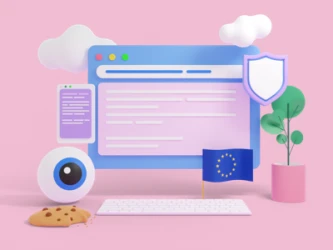Get Started with Google Consent Mode v2
GetTerms supports Google Consent Mode v2. In this article we show you how to configure it in a few simple steps.

Create a tailored Privacy Policy, Terms & more in under 5 minutes.

Safeguarding personal data is not just a priority, it is a necessity. Enter the General Data Protection Regulation (GDPR), the champion of data protection, setting the rules for businesses to respect the privacy of personal information across the EU. Understanding your requirements to meet GDPR compliance might feel daunting, so we’ve put together a simplified GDPR Checklist to help you navigate this complex topic.
Know Your Data: Embarking on a journey to GDPR compliance begins with a deep understanding of the personal data you’re dealing with. It’s not just about knowing where this data is stored; it’s also about comprehending how it flows within the intricate web of your organization. Think of this understanding as your compass, guiding you towards effective compliance.
Legal Grounds: GDPR, with its myriad of rules and principles, firmly asserts that personal data must only be processed on legitimate legal grounds. Your task is to identify these lawful bases for processing personal data and ensure they align seamlessly with GDPR’s guiding principles. Whether it’s the necessity of processing for a contract, adherence to a legal obligation, protection of vital interests, performance of a task carried out in the public interest, or the consent of the data subject, understanding these legal grounds is paramount.
Data Mapping:
Picture this: you’re on a treasure hunt, except the treasure is the personal data within your organization, and the map you need is the data flow diagram. Creating a data flow map allows you to visualize how data moves within your organization. It’s like being handed a treasure map, helping you pinpoint potential vulnerabilities and risks associated with data processing activities. By understanding the journey of personal data, you’re better equipped to identify and address security and compliance gaps.
Transparency Is Key Transparent Privacy Policy: Your privacy policy is like the beacon guiding you safely through the GDPR labyrinth. To be effective, it must be clear, concise, and easily accessible to individuals. Within this document, you need to explain what personal data you collect, how it’s used, and, most importantly, the rights individuals have regarding their data. It’s not merely a legal requirement; it’s an opportunity to build trust with your customers, demonstrating your unwavering commitment to transparent data handling.
Consent Procedures: Consent, in the realm of GDPR, is your golden key to unlocking data processing. Review your consent mechanisms and ensure they meet the high standards set by GDPR. Consent should be explicit, informed, and as easy to withdraw as it is to give. In essence, it means individuals must actively agree to the processing of their data, be fully aware of what they’re consenting to, and with the freedom to change their minds at any time. Clear and affirmative consent is the linchpin of GDPR.
Data Retention: Imagine your organization as a ship. Just as a ship mustn’t accumulate excess cargo, your organization shouldn’t accumulate data beyond its necessary journey. Here, a clear data retention policy acts as your compass. This policy ensures that personal data is stored only for as long as it’s needed for the purpose for which it was collected. Regularly review and, if necessary, jettison data that is no longer required to remain compliant with GDPR.
Encryption: In the GDPR fortress, encryption serves as your impenetrable shield. It’s not just about securing data; it’s about securing it robustly. Whether it’s data at rest or in transit, your personal data must be protected by strong encryption measures. This encryption isn’t just your first line of defense; it’s your castle walls against unauthorized access and data breaches.
Access Controls: Imagine a castle with restricted entry; only those with permission may enter. That’s how your data should be protected. Limit access to personal data to authorized personnel only. Implement role-based access controls, ensuring that individuals within your organization only have access to data essential for their roles. This minimizes the risk of data breaches originating from within your castle walls.
Incident Response Plan: Every castle has its contingency plan for when trouble arises. In GDPR’s case, it mandates that organizations have a well-defined incident response plan. This plan should serve as your knight in shining armor, outlining the procedures for addressing and reporting data breaches. Under GDPR, data breaches are akin to declaring a state of emergency; they must be reported to the relevant authorities and individuals affected within 72 hours of becoming aware of the breach.
Access Requests: GDPR makes individuals the heroes of their data stories, giving them the power to access their own data. To prepare for this, you must be ready to respond efficiently to data subject access requests. Individuals have the right to know what personal data you hold about them, why you hold it, and how it’s processed. Ensure your processes and documentation are in place to address these requests swiftly and transparently.
Right to Erasure: GDPR introduces the concept of the “right to be forgotten.” This means individuals have the power to request the deletion of their personal data under specific circumstances. Your organization should be capable of erasing this data promptly upon request as if it were never there in the first place.
Data Portability: Think of data portability as a magic carpet that allows individuals to take their data and fly it over to another service. Enable data subjects to receive their data in a commonly used format, making it easy for them to transfer their data elsewhere. This empowers individuals with greater control over their information and serves as a cornerstone for data mobility.
Data Processing Agreements (DPA): Your data doesn’t just stay within the castle walls; sometimes, it ventures outside. In these cases, you must have Data Processing Agreements in place. These agreements serve as your treaties with other kingdoms, confirming that these third parties comply with GDPR and uphold the same high data protection standards as you do.
Vendor Assessment: To ensure your allies are true to your cause, regularly assess the data protection practices of your service providers. They’re an extension of your kingdom, and you share the responsibility for the personal data you entrust to them.
Awareness Programs: In your kingdom, every member must understand their role in defending the fortress. GDPR compliance isn’t just about IT or legal; it’s about your entire army of employees understanding their roles and responsibilities in data protection. Implement awareness programs to ensure your staff is well-informed about GDPR compliance and the vital role they play in protecting personal data.
Regular Updates: The GDPR landscape is like shifting sands, ever-changing. Your kingdom must keep a vigilant watch on these developments.
Data Protection Officer (DPO): Appoint a Data Protection Officer (DPO) if required by GDPR.
Data Protection Impact Assessments (DPIAs): Conduct DPIAs to identify and mitigate risks associated with data processing activities.
Incident Reporting: Establish a clear procedure for reporting data breaches internally and to the relevant authorities within 72 hours.
Documentation: Maintain detailed records of data breaches, responses, and actions taken for compliance and improvement.
[ ] Know Your Data
[ ] Legal Grounds
[ ] Data Mapping
[ ] Transparent Privacy Policy
[ ] Consent Procedures
[ ] Data Retention
[ ] Encryption
[ ] Access Controls
[ ] Incident Response Plan
[ ] Access Requests
[ ] Right to Erasure
[ ] Data Portability
[ ] Data Processing Agreements
[ ] Vendor Assessment
[ ] Awareness Programs
[ ] Regular Updates
[ ] Data Protection Officer
[ ] Data Protection Impact Assessments
[ ] Incident Reporting
[ ] Documentation
By diligently following GetTerms’ GDPR Compliance Checklist, you’ll be well-prepared to face your GDPR compliance journey, secure your personal data, and demonstrate your commitment to respecting individuals’ privacy.
The path toward GDPR compliance might seem difficult, but GetTerms’ GDPR Compliance Checklist simplifies the process. However, compliance goes beyond checkboxes, it’s about cultivating a culture of data respect and transparency. Whether you’re a business owner or a privacy-conscious individual, understanding GDPR will be beneficial in helping you navigate the online world.
Need support with GDPR ready policies? You can count on us. We provide clear guidance, uphold data respect, and understand that data protection is more than a legal obligation. Create your tailored GDPR-compliant Privacy Policy here at GetTerms.